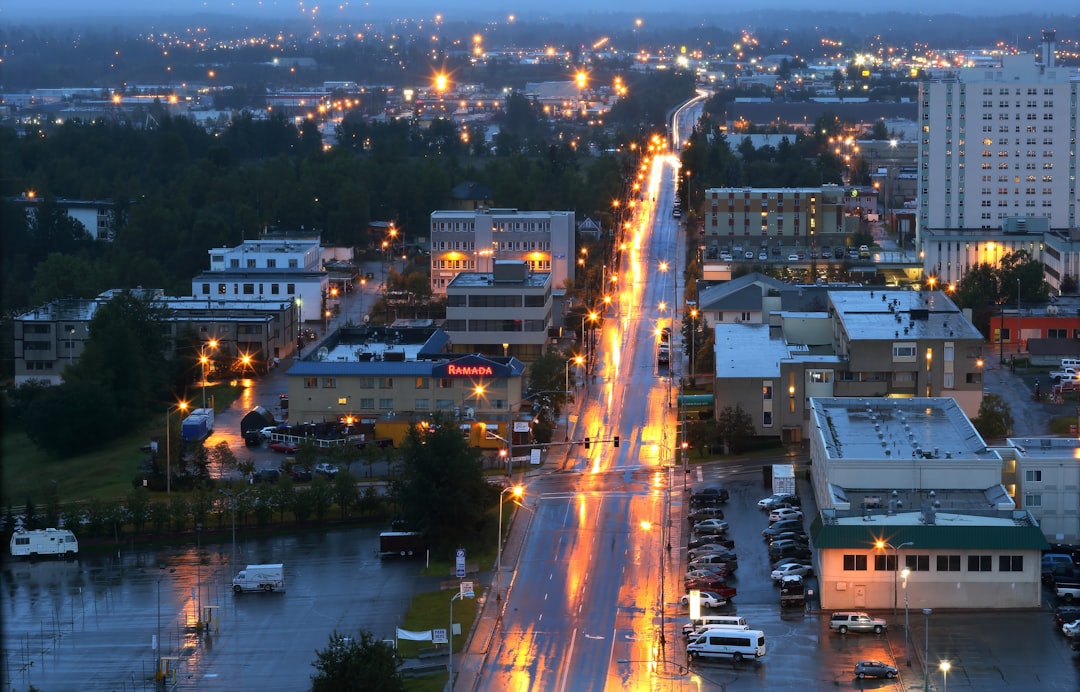Alaska's (Worrying) Economic Trends
Meanwhile, wages in even one of the state's highest-paying industries aren't keeping up with inflation and the Permanent Fund Corp. moves forward with its new Anchorage office

Happy Saturday, Alaska!
In this edition: Catching up on some of the big headlines this week, which includes another round of worrying headlines about the state of Alaska’s economy and the problems created by the ongoing outmigration of workers to greener pastures in the Lower 48. While reversing the trend will take a lot, one of the easiest solutions has been apparent for a while. Meanwhile, the Alaska Permanent Fund Corporation is moving forward with an Anchorage office despite warnings that it’ll infuriate legislators. Several Alaska tribes and the University of Alaska Fairbanks got an infusion of federal money to help repatriate remains and cultural items. Anchorage’s zoning fight rages on but the city took a step forward on cycling. Also, the reading list and weekend watching.
Current mood: 😬
Worrying economic trends

The latest edition of the Department of Workforce and Labor Development’s Alaska Economic Trends magazine came out this week, driving several stories about yet another worrying sign in Alaska’s economy. This round focuses on the state of the construction industry, which has fared somewhat better than other industries but is still lagging behind its pre-covid numbers despite growing demand and federal investment. It’s not precisely clear what’s driving the problem, but the report points to a shrinking workforce created by retirements and outmigration.
It’s a story that seems to be playing out in pretty much every corner of Alaska’s economy. According to reporting by KDLL, the Central Peninsula Hospital is facing a particularly bad workforce crunch as younger health care workers—facing the lack of affordable child care, the quality of schools and other factors—are looking Outside. A report by the Anchorage Daily News shows about one of every twelve of all city bus rides last week were canceled due to low staffing. The system’s ailing in large part because long-time employees are leaving and aren’t being replaced.
The Economic Trends report also includes this telling line about the state’s construction industry, which is on the higher end of pay among the state’s industries:
“While the construction industry is high-paying, its recent increases didn’t keep
up with inflation. Wages in 2022 were about $4,000 higher than in 2019, but just breaking even with inflation over those three years would have required a $10,000 boost.”
As is the case with pretty much any story about the labor shortage, the solution seems to be the same: Pay people better.
That’s been the answer for the state’s child care availability shortage for a few years now. Sure, there are changes around the edges that would improve the situation but by and large, the underlying problem the state’s facing is that child care is simultaneously too expensive for many to afford and doesn’t pay enough to be a long-term job. The Legislature got that message in this last session, approving several increases to child care grants and early education this year and advancing legislation aimed at improving the industry’s underlying financial situation through items like tax credits and more grant opportunities.
But as with all things, Gov. Mike Dunleavy seems to have different plans. He vetoed part of the funding for those child care grants from the budget, arguing that his newly formed child care task force needs to take the lead on addressing the problem and the state should wait for that report back to the Legislature for next year’s session. That means it’ll likely be into next summer before any of the solutions can come online—and that’s not to mention it’ll require legislative discipline for it to get through in time.
Meanwhile, the outmigration continues.
Read more:
- ADN, Aug. 10: Anchorage’s city bus driver shortage brings cancellations and delays for riders
- ADN, Aug. 8: Amid a statewide labor shortage, Alaska builders are delaying projects and relying on Outside workers
- Alaska Beacon, Aug. 8: Alaska construction employment statistics show uneven post-pandemic recovery, wage deflation
- Alaska Beacon, July 3: Dunleavy veto cuts Head Start increase as centers struggle to pay teachers, serve children in need
- From KDLL, Aug. 4: Small exodus of doctors leaves central peninsula with recruitment rush, strains on care
APFC moves forward with Anchorage office over warnings it will rankle legislators

When the Alaska Permanent Fund Corporation’s Board of Trustees met last month, former state Sen. Gene Therriault warned about the board’s fixation with opening an Anchorage office. Opening the office without legislative approval, he said, “may irreparably damage the corporation’s relationship with the Alaska Legislature.”
On Thursday, nearly a month after receiving the warning, the Board of Trustees announced their plans to push ahead with opening the office by the end of this calendar year, bypassing legislative approval. The decision this week to proceed was first reported by Alaska Beacon, with officials arguing that the expense would pay for itself with improved recruitment and retention of fund employees. Trustees have been pushing for an Anchorage office for a while now, and Dermot Cole has some important backstory in a post back from June here.
At July’s meeting, Therriault doubted that justification. He pointed out that the number of employees who said they would move to Anchorage was smaller and less certain than the Board of Trustees had represented and that retention doesn’t seem worse than it has been in the past.
“Although addressing high staff turnover is the suggested reason for establishing an Anchorage office, the historical turnover information indicates that turnover is not unusually high currently,” he said, later adding, “Without a compelling and time-sensitive reason to move forward now … your actions would likely cause long-standing tensions with the legislative branch of government.”
It’s not immediately clear how much the Anchorage office will cost. The estimated cost for a standalone office sat around $1 million, but the fund will be using office space already leased by the Department of Environmental Conservation (a suggestion of soon-to-be-former DEC Commissioner Jason Brune).
Board Chair Ethan Schutt told the Beacon that he hopes the move can prove the value of the office, potentially winning legislative support for a future standalone office.
That may be a hard sell.
Legislators are already wary about the Board of Trustees after the abrupt firing of well-liked CEO Angela Rodell in late 2021, which spurred accusations the board was acting as a political arm of Gov. Mike Dunleavy. A legislative investigation didn’t turn up concrete evidence that Gov. Mike Dunleavy orchestrated the firing, but found the board failed to follow good process in the firing. The Anchorage office is also seen as part of the Dunleavy administration’s ongoing efforts to move state government away from Juneau and centralize power in Anchorage.
The Alaska Memo by Matt Buxton is a reader-supported publication. To receive new posts and support my work, consider becoming a free or paid subscriber.
Alaska tribal repatriation grants

A new round of funding will help bring some of the many stolen Indigenous cultural items and remains home from museums around the world.
This week, the National Park Service announced another round of funding under the Native American Graves Protection and Repatriation Act will include about $350,000 in grants for Alaska tribes and the University of Alaska Fairbanks to pursue repatriation efforts.
Funding will specifically be going to the Central Council of Tlingit and Haida Indian Tribes of Alaska and Qawalangin Tribe of Unalaska, according to the Alaska Beacon, that will be used to continue their repatriation efforts. According to that report, Tlingit and Haida has returned more than 130 objects since its first grant in 1993. UAF, the Alutiiq Museum and Archaeological Repository, the Central Council of Tlingit and Haida Indian Tribes of Alaska will also receive funding for consultation meetings with museums and universities to identify and return other items.
Read more:
Alaska Beacon: Alaska tribes, university to receive federal grants for repatriation of remains and cultural items
Fairbanks Daily News-Miner: Alaska tribes, UAF awarded federal grants for Native repatriation purposes
Anchorage cycling ordinance

Anchorage’s battle over the future of zoning continues to rage on, but this week marked a meaningful step forward when it comes to improving the city’s transportation options. The Anchorage Assembly approved an initiative this week that brings a load of significant changes for cyclists and pedestrians, which will go into effect on Oct. 7, 2023. They include:
- The “Anchorage Stop,” allowing cyclists and other “vulnerable road users” to treat stop signs like yield signs and red lights like stop signs.
- Clarifies that bike lanes are open to other “vulnerable road users,” which includes wheelchairs and e-scooters (but not people walking)
- Removes fines for jaywalking citations, legalizing crossings where crosswalks and other crossings are not nearby.
- Adds several definitions to city planning, like protected bike lanes, cycle tracks and buffered bike lanes.
- Eliminates municipal fines for some bike equipment citations, like riding without a bell or valid bicycle registration.
In a prepared statement Anchorage Assemblymember Anna Brawley said the legislation represents a change in how the city is focusing its resources on transportation, aimed at being more fair and friendly to everyone using the roads.
“Overall, I really appreciate the community dialogue about how we improve safety on our roads,” she said. “Everyone wants to feel safe, whether you drive a car or use a bike or walk around town. How much we use enforcement, education, encouragement, and engineering is an ongoing conversation in a lot of our work around public safety, so I’m glad this ordinance has gotten people thinking critically about how we make Anchorage roads safer for everyone.”
Read more:
Alaska Public: Anchorage Assembly passes code changes aimed at making city more bike-friendly
Reading list
- Alaska Beacon: Alaska Permanent Fund Corp. plans to open Anchorage office by year’s end
- Alaska Beacon: Federal judge upholds pause on pre-development oil work in Arctic refuge
- Alaska Public: U.N. rapporteurs and Patagonia take Willow opposition to new level
- KTOO: Lost and found: After the flood, Juneau residents return lost treasures to families
- An illustrated scientific explanation of the phenomenon by the Alaska Climate Adaptation Science Center: Hidden Water: The Suicide Basin Outburst Flood
- Juneau Empire: City seeks state, federal assistance in aftermath of record Suicide Basin flooding
- KNOM: Viral ‘Fish Camp Barbie’ celebrates Alaska Native heritage
- Kuba’s Korner newsletter: 8 Ways to Help Local Candidates You Believe In
- ProPublica: Years After Being Ticketed at School for a Theft She Said Never Happened, Former Student Prevails in Court
- Washington Post commentary: John Eastman shows the path from misinformation to revolution
Weekend watching
One of my go-to YouTube channels in the last couple months has been Matt’s Off Road Recovery, which documents the feats of a Utah-based towing company that handles a bunch of particularly precarious recoveries in the region.
Have a nice weekend, y’all.
The Alaska Memo by Matt Buxton is a reader-supported publication. To receive new posts and support my work, consider becoming a free or paid subscriber.
The Alaska Memo Newsletter
Join the newsletter to receive the latest updates in your inbox.




